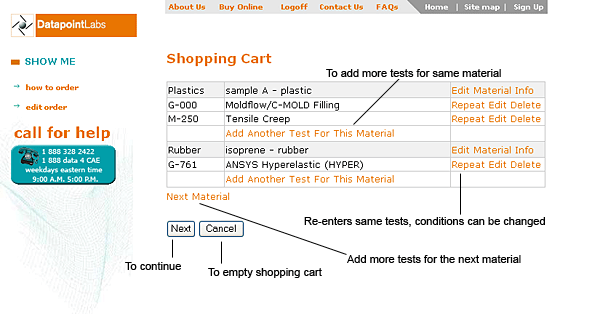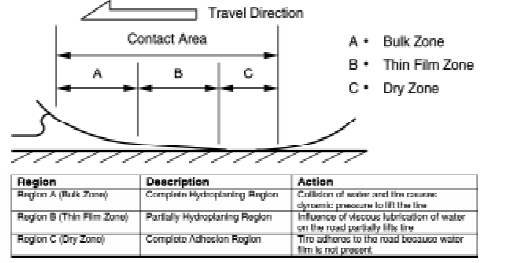 Viscoelastic models for blowmolding and thermoforming
simulations
Viscoelastic models for blowmolding and thermoforming
simulations
In thermoforming applications, the polymer sheet acquires its final
shape after having undergone deformations. These deformations are
essentially dominated by elongation components. However, contrary
to continuous processes such as fibre spinning or film casting,
the extensions occurring in thermoforming remain usually moderate.
Typically, one may encounter Cauchy strains of the order of 5, and
the corresponding Hencky strains are thus of the order of 1 or 2.
Consequently, the knowledge of the linear response is usually sufficient,
since the deformations involved are such that the expected polymer
response essentially remains within the scope of the linear viscoelastic
properties.
Indeed, if one considers typical transient elongational viscosity
curves for several polymers, one finds that they follow the linear
response up to a Hencky strain of about 2, whatever the strain rate.
The deviation with respect to this quasi-linear behavior starts
beyond a Hencky strain of about 2, thus when the shaping process
is already achieved. Furthermore, one usually observes a strikingly
similar behavior of the transientelongational viscosity at increasing
strain rates. In particular the deviation with respect to the linear
behavior is found beyond a Hencky strain of 2. This permits an estimate
of the elongational behavior at strain rates that are not achievable
in measurements,
and that are typical in the industrial practice.
From the point of view of the modelling, multimode viscoelastic
models exhibit the same early development of the transient elongational
viscosity. This is a consequence of the linear properties, which
are fully described by means of the oscillatory measurement (G’
and G”). This is an interesting feature, since the use of
a quasi-linear viscoelastic model with a relaxation spectrum identified
on the basis of linear properties is sufficient for performing a
simulation of a broad range of thermoforming applications.
Author’s Note:
Definition of Cauchy and Hencky strains.
Let us consider a material element of initial length L0, and stretched
up to a length L. The Cauchy strain eC is defined as the ratio of
the current length L to the initial one:

The Hencky strain eH is defined as the sum of all infinitesimal
strains from the initial length L0 to the deformed state of length
L:

References:
C.W. Macosko, Rheology, principles,
measurements, applications. Wiley-VCH (1994) A.S. Lodge, Trans Faraday
Soc., 52 (1956) 120-180.
Simulating hydroplaning using MSC.DYTRAN
Predicting tire tread patterns that minimize the effects of hydroplaning
is a critical safety issue for tire manufacturers. Hydroplaning
occurs when a vehicle reaches a certain velocity on a wet road and
the tire lifts off the road, minimizing contact and friction with
the road surface.
MSC.Dytran was utilized to simulate hydroplaning velocity, including
interaction between tire tread design, deformation and surrounding
fluids, because of its superior analysis of coupled problems between
fluids and structures. Using finite element method (FEM) to solve
structural deformation and finite volume method (FVM) to solve fluid
behavior, MSC.Dytran can accurately predict the tire performance
running on a wet road by coupling the two methods. For this simulation,
the tire structure is modeled by Lagrangian formulation (FEM) and
the fluid is modeled by Eulerian formulation (FVM).
Hydroplaning can best be explained with the three-zone concept shown
in Figure 1. When a vehicle drives at low speed, Region C dominates
the contact patch. As velocity increases, Region A becomes dominant
and when the tire is completely lifted, region C diminishes. This
simulation targets Region A, analyzing the dynamic pressure caused
by the collision of water film and the front edge of the tire. When
the tire begins lifting off the road, hydroplaning velocity has
been achieved.
 Figure 1. Three zone concept
Figure 1. Three zone concept
Tires are composite material structures made up of many different
components, including carcass, belts, cap tread, side tread, and
bead core. The carcass and belt have high elastic modulus and thin
composite materials, so they are modeled using multi-layered shell
elements. This reduces the number of iterations that would have
been computed had continuum elements been used. Likewise, the bead
core has a very high elastic modulus and is modeled as rigid elements,
reducing the number of iterations computed. All of the other tire
components are modeled with 8-node continuum elements.
The geometrically complex tire tread pattern is modeled using finite
elements. Then the tire body is modeled separately. The two models
are combined with a rigid connection (Figure 2). This eliminates
coinciding nodes at the interface surface between tire and tread
pattern, enabling the FE modeling of tread patterns with complex
and arbitrary shapes.
The water layer is modeled using 8-node continuum elements. The
bottom surface of the water layer coincides with the road surface
that was modeled as a rigid body, and the water layer is defined
on the upper side of the road surface with a thickness of 10 mm.
On top of the water layer, a vacant space called void is defined
to enable water scattering. By defining the Eulerian elements initially,
where water is expected to move, free surface of water can be simulated
and enables the analysis of water scattering drained by tread patterns.
Element size of water layer needs to be less than or equal to the
tire groove width. However, if finer meshes are adapted to the entire
region of water layer, the computation time becomes impractical.
To obtain sufficient accuracy and to reduce processing time, water
layer around contact area where deformed tire and fluid interfere
is equally divided into small size meshes. In the other region away
from the contact region, the sizes of the mesh are increased according
to the geometric ratio as shown in Figure 3. (Water is assumed to
be incompressible and also a laminar flow).
The General Coupling algorithm of MSC.Dytran was utilized because
it enables tire deformations to couple with surrounding fluid by
overlapping on the fluid elements. This allows modeling of the hydroplaning
phenomena in which surrounding fluid is drained by the complex tread
pattern of the tire. In order to reduce the number of elements to
a manageable number, a moving reference frame fixed on the traveling
vehicle is used.
Instead of the tire moving on the fixed road, the transverse velocity
is applied to the road and the tire rotates at the fixed position.
Simultaneously, inertial force is applied to the fluid so that the
same velocity as the road surface is generated. This simulates a
reduction in the contact force between tire and road as flow velocity
increases and dynamic pressure of the water lifts the tire incrementally.
The relationships between fluid velocity and contact force determine
hydroplaning velocity.
To verify the effectiveness of simulation for predicting hydroplaning
velocity, four different tread patterns, including smooth, 9mm wide
longitudinal groove 18mm wide longitudinal groove and a V-shape
groove were modeled and compared with physical tests. Specifications
of the tires are 195/65R15, vertical load 4kN and inflation pressure
200kPa.
The predicted hydroplaning velocities for the four tread patterns
were compared to experiments with physical tires. The simulation
results were confirmed. Additionally, simulated water flows around
contact patch area agreed with the video of the experiment. As a
result, the new procedure enables a prediction of the hydroplaning
process and differences in performance based on the tread pattern
of the tire.
-Casey Heydari, MSC.Software
Accreditation scope widens
DatapointLabs maintains an active program to continuously add new
tests to its A2LA Scope of Accreditation. Some of the latest additions
are listed below:
ASTM D412: Vulcanized Rubber and Thermoplastic
Elastomers-Tension
ASTM D575: Rubber Properties in Compression
ASTM D648: Deflection Temperature
of Plastics Under Flexural Load in the Edgewise Position (HDT)
ASTM D1525: Vicat Softening Temperature
of Plastics (VST)
ASTM D6110: Charpy Impact Resistance
of Notched Specimens of Plastics
ISO 75: Determination of Temperature
of Deflection Under Load (HDT)
ISO 179-1: Plastics-Charpy Impact
Properties: Non-Instrumented
ISO 180: Plastics: Izod Impact Strength
ISO 306: Plastics-Determination of
Vicat Softening Temperature (VST)
ISO 604: Plastics-Determination of
Compressive Properties
ISO 6603-2: Multiaxial Impact Behavior
of Rigid Plastics-Instrumented Impact Test
ISO 6721-7: Plastics-Determination
of Dynamic Mechanical Properties
ISO 11357-2: Plastics-Differential
Scanning Calorimetry (DSC)-Determination of Glass Transition Temperature
ISO 11357-3: Plastics-Differential
Scanning Calorimetry (DSC)-Determination of Temperature and Enthalpy
of Melting and Crystallization
For the latest Scope of Accreditation, see:
www.datapointlabs.com/qualitysystem.asp
-Craig Montoya, Quality Manager
Upcoming events
POLYFLOW Users’ Group Meeting,
Court-St-Etienne, Belgium, Oct. 1,2, 2002
Materialica, Munich,Germany, Sep.
30th-Oct. 2nd, 2002
CAD-FEM Users’ Meeting, Friedrichshafen,
Germany, Oct. 9-11, 2002
ISO TC 61, Quebec City, Canada, Nov.
13, 14, 2002
New Support Engineer joins team
DatapointLabs would like to introduce our new Team member, Support
Engineer, Brian Croop. Brian holds a degree in Mechanical Engineering
Technology (Penn State, Erie). Brian will be utilizing his engineering
and CAE skills to fully understand and support the needs of DatapointLabs’
clients.
New TestPaks® for Polyflow,
Dytran
New TestPaks
® have been added to meet the complete material
model needs of blowmolding and thermoforming simulations using Polyflow
(see article below):
Polyflow Thermoforming (Isothermal)
Polyflow Thermoforming (Non-Isothermal)
Polyflow Blowmolding (Isothermal)
Polyflow Blowmolding (Non-Isothermal)
DatapointLabs is proud to announce the addition of MSC.DYTRAN to
the list of programs supported by its TestPaks
® Alliance Program.
The following new TestPaks
® are available to meet the material
modeling needs of MSC.Dytran users:
MSC.Dytran Isotropic Elastic (DMATEL)
MSC.Dytran Piecewise Linear Plasticity (DYMAT24)
MSC.Dytran High Speed Piecewise Linear Plasticity
(DYMAT24)
Please visit
www.datapointlabs.com/
PartnerPrograms.asp to view additional TestPaks
®, or call
toll free (US) for details: 1-888-data-4-cae (1-888-328-2422)

